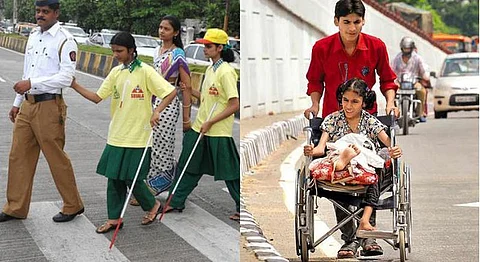
- HOMEGROWN WORLD
- #HGCREATORS
- #HGEXPLORE
- #HGVOICES
- #HGSHOP
- CAREERS
- ABOUT US
- CONTACT US

In late December 2021, following the International Day of Persons with Disabilities on 3 December, Marina Beach in Chennai was made accessible to differently-abled persons with a wooden pathway leading up to the water, so that those who use wheelchairs could access the shore. Commendable in thought, this idea held one fundamental loophole. The pathway was temporary, perhaps for the sake of awareness and was in use for just one week.
Such instances make one wonder – ‘accessibility’ ought to mean vastly different things to people based on their abilities, or the lack of them. Physical disabilities include those of mobility, hearing, speech, and sight. All of these call for amenities that are specially built. It is safe to say that most places in India are woefully inaccessible to differently-abled people, but how do we go about changing that?
When the accessibility of persons with disability is treated as an option (before or after receiving sanctions), the problem arises. Any kind of design implementation must begin with inclusion – if not, the term ‘accessible to the public’ is essentially false. Several surveys and research material exists on solving the issue of all-accessibility in Indian cities and spaces, but their execution is next to non-existent.
We also wondered, how deeply do design and architecture impact accessibility?
We posed this very question to a team of architects from the firm Kabir Hira Architects in Bengaluru, and they let us in on their two cents on the current reality of India as it pertains to the sheer lack of accessibility for differently-abled people.
It was made clear at the outset by the team that accessibility begins at the designing stage. To think inclusively is where the process must begin, and integration of amenities and special provisions must be done at this stage too.
Homegrown: What does the process of making public spaces accessible to disabled persons look like?
Kabir Hira Architects: Most of the provisions made by builders are to receive sanctions to build the structure. No further thought is usually put in to make the area all-accessible. For example, a wheelchair ramp’s height to length ratio is meant to be 1:12, but builders place a namesake ramp which is often too steep. Similarly, buildings will have washrooms for handicapped persons but will have stairs leading to that very washroom. Additionally, most of the guidelines pertain to physically disabled people excluding those with other types of disabilities.
HG: What shortcomings does India face when it comes to building all-accessible structures?
KHA: Usually in design and architecture education, the inclusion of differently-abled persons is absent. The challenges faced by them are not privy to us, and their absence reinforces this cycle. There is a lack of encouragement for them to be present in this space.
HG: How can India be more accessible for differently-abled persons?
KHA: Awareness is absolutely crucial. The client you are designing for has to be sensitive to the fact that all types of people will use the space. An architect can suggest it to them, but the last call is theirs.
HG: Do different public spaces have different standards for accessibility-centred design?
KHA: We need to remember to be accommodative in our designs regardless of the space. It needs to begin with a thought. For example, not many will realise that even lift buttons need to be placed slightly lower for those in wheelchairs to be able to access them. If one decides to use lifts for all-accessibility and does not ensure that the lift itself is accessible, it defeats the purpose. Tactile flooring (textured grounds to guide visually-impaired persons) needs to be ensured in public spaces. Every traffic signal should have a sound alarm for the space of time when pedestrians are allowed to cross the road which helps visually-impaired people but where do we see it?
HG: What should architects/urban planners/civil engineers keep in mind before they begin work on a structure, to make it fully accessible to everyone?
KHA: Our job roles call for us to solve design problems. If we do not even know these problems, we cannot pose solutions. This makes it imperative to understand the various forms of disabilities and the challenges each of them poses with regard to access to public spaces. We all need to have the sensitivity to introduce and incorporate designs that are all-inclusive. This architectural or design thought should not be limited to just our profession, but to those involved at every step of the way, including the authorities that give out sanctions. We must encourage differently-abled people to be comfortable with those in our profession, and maybe even provide inputs.
HG: Are there any laws/procedures/guidelines that hinder the process of building or making public spaces accessible to disabled persons?
KHA: There are no design guidelines or limitations that inhibit a barrier-free space. Many countries have public spaces where it is the norm to be inclusive of various disabilities. In India, people lack the sensitivity to incorporate their experiences. If the client is not sensitive enough to the topic, there is not much that can be done.
Accessibility to public spaces is no less than a human right, but it is often denied to those that are differently-abled due to poor design and execution. A problem may not impact everyone for it to call for the need to be solved. It is estimated that disability (physical and mental) affects 2.2 per cent of the population of India – that may sound small until you realise that that is 2.68 Crore people.
The fact that such a large number of people do not receive access to places that others do simply based on differences in ability, and nothing else is something that must be sorely addressed to move closer to a truly equitable society.
If you enjoyed reading this, we suggest you also read:
